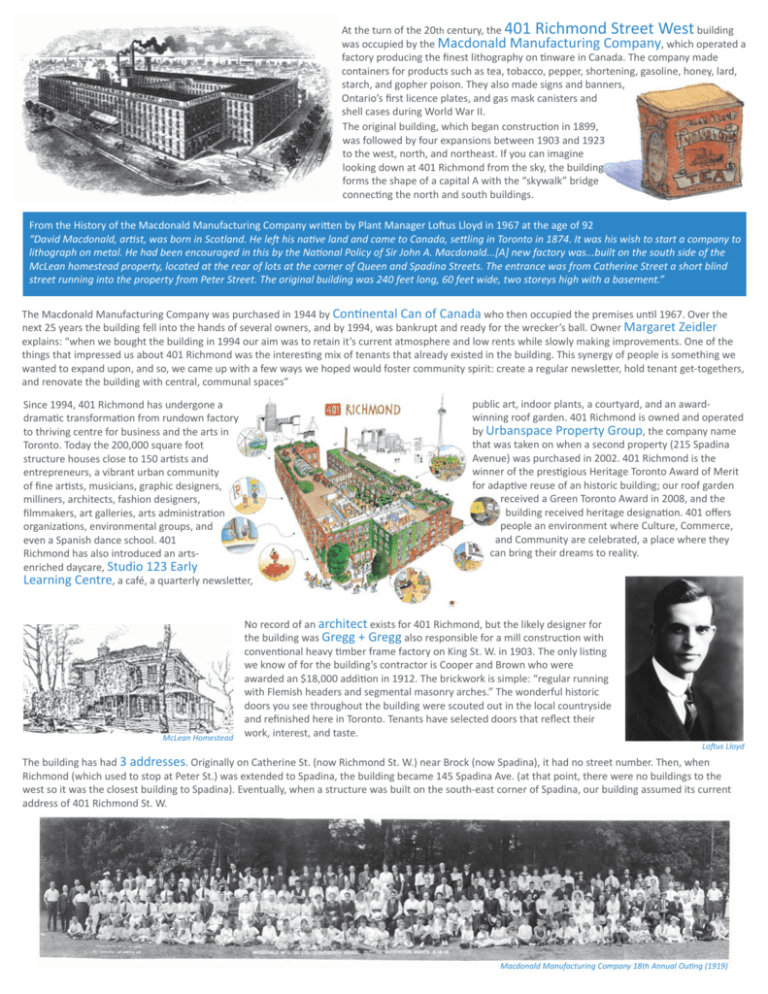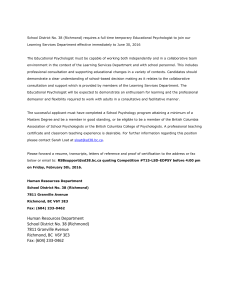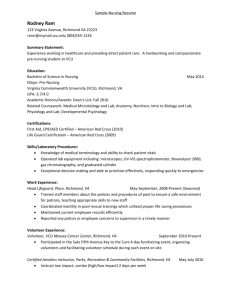history and architecture
advertisement

At the turn of the 20th century, the 401 Richmond Street West building was occupied by the Macdonald Manufacturing Company, which operated a factory producing the finest lithography on tinware in Canada. The company made containers for products such as tea, tobacco, pepper, shortening, gasoline, honey, lard, starch, and gopher poison. They also made signs and banners, Ontario’s first licence plates, and gas mask canisters and shell cases during World War II. The original building, which began construction in 1899, was followed by four expansions between 1903 and 1923 to the west, north, and northeast. If you can imagine looking down at 401 Richmond from the sky, the building forms the shape of a capital A with the “skywalk” bridge connecting the north and south buildings. From the History of the Macdonald Manufacturing Company written by Plant Manager Loftus Lloyd in 1967 at the age of 92 “David Macdonald, artist, was born in Scotland. He left his native land and came to Canada, settling in Toronto in 1874. It was his wish to start a company to lithograph on metal. He had been encouraged in this by the National Policy of Sir John A. Macdonald...[A] new factory was...built on the south side of the McLean homestead property, located at the rear of lots at the corner of Queen and Spadina Streets. The entrance was from Catherine Street a short blind street running into the property from Peter Street. The original building was 240 feet long, 60 feet wide, two storeys high with a basement.” The Macdonald Manufacturing Company was purchased in 1944 by Continental Can of Canada who then occupied the premises until 1967. Over the next 25 years the building fell into the hands of several owners, and by 1994, was bankrupt and ready for the wrecker’s ball. Owner Margaret Zeidler explains: “when we bought the building in 1994 our aim was to retain it’s current atmosphere and low rents while slowly making improvements. One of the things that impressed us about 401 Richmond was the interesting mix of tenants that already existed in the building. This synergy of people is something we wanted to expand upon, and so, we came up with a few ways we hoped would foster community spirit: create a regular newsletter, hold tenant get-togethers, and renovate the building with central, communal spaces” Since 1994, 401 Richmond has undergone a dramatic transformation from rundown factory to thriving centre for business and the arts in Toronto. Today the 200,000 square foot structure houses close to 150 artists and entrepreneurs, a vibrant urban community of fine artists, musicians, graphic designers, milliners, architects, fashion designers, filmmakers, art galleries, arts administration organizations, environmental groups, and even a Spanish dance school. 401 Richmond has also introduced an artsenriched daycare, Studio 123 Early Learning Centre, a café, a quarterly newsletter, McLean Homestead public art, indoor plants, a courtyard, and an awardwinning roof garden. 401 Richmond is owned and operated by Urbanspace Property Group, the company name that was taken on when a second property (215 Spadina Avenue) was purchased in 2002. 401 Richmond is the winner of the prestigious Heritage Toronto Award of Merit for adaptive reuse of an historic building; our roof garden received a Green Toronto Award in 2008, and the building received heritage designation. 401 offers people an environment where Culture, Commerce, and Community are celebrated, a place where they can bring their dreams to reality. No record of an architect exists for 401 Richmond, but the likely designer for the building was Gregg + Gregg also responsible for a mill construction with conventional heavy timber frame factory on King St. W. in 1903. The only listing we know of for the building’s contractor is Cooper and Brown who were awarded an $18,000 addition in 1912. The brickwork is simple: “regular running with Flemish headers and segmental masonry arches.” The wonderful historic doors you see throughout the building were scouted out in the local countryside and refinished here in Toronto. Tenants have selected doors that reflect their work, interest, and taste. Loftus Lloyd The building has had 3 addresses. Originally on Catherine St. (now Richmond St. W.) near Brock (now Spadina), it had no street number. Then, when Richmond (which used to stop at Peter St.) was extended to Spadina, the building became 145 Spadina Ave. (at that point, there were no buildings to the west so it was the closest building to Spadina). Eventually, when a structure was built on the south-east corner of Spadina, our building assumed its current address of 401 Richmond St. W. Macdonald Manufacturing Company 18th Annual Outing (1919) Translation of the latin phrase above the courtyard doors to Studio 123 Early Learning Centre On every floor: walls were repainted; hallways opened up; clerestory windows installed (interior windows placed high on the wall to allow sunlight into the hallway from studio spaces); many steel doors were replaced with more individual, and often historic wood doors; and floors were refinished. An attempt has been made to create a clear sight line along every hallway, not only for safety, but to enhance a sense of “openness” in the building. Some special discoveries were made like the original iron door that led to a onestorey tin vault on the ground floor and ceilings covered with sheets of tin “proofs” (the pieces that were run through the lithography machines as a test before the final printing was done). In some cases, the artwork or logos are still visible on the tin remnants. Courtyard view of bridge In the courtyard, two small brick structures were removed (the tin vault being one of them) to provide space for an inner courtyard. The new design included: cedar benches; a beautiful birch tree (a gift from a group of tenants); several flower beds; and a sandbox for the children. An open steel spiral staircase makes the courtyard accessible to tenants from all four levels, provides a great vantage point to see the courtyard, and is an ideal lattice for our creeping vines. When the restoration team removed rusted corrugated siding from the bridge, a beautiful cross-hatch wood structure was revealed beneath. Painstaking work followed: glazing the existing framework; insuring that the glazing wouldn't leak; and creating new hinged windows that matched the old style present elsewhere in the building. Then glass was added and the finished product presents a fantastic view to the east and west sides of the building. A key feature of 401 Richmond’s design is its fenestration or grand windows. When the new owners took over in 1994, the over 800 windows in the building had been neglected for decades. A conscious decision was made to restore them, a mammoth job and major committment for our restoration team. There are two basic window types; the metal ones (in the 1923 portion of the building) had the opaque glass stripped out with propane torches and were repainted and glazed. The other double-hung windows made of white pine around the turn of the 20th century, involve the removal of old glass, heat stripping to remove the putty and several layers of old paint, and then replacement of broken or rotted parts (where possible old glass was retained). Then they are primed, reglazed, reputtied, painted on the exterior, weather-stripped, and re-hung with new sash cords. “I like seeing these beautiful old antiques restored instead of junked” says Property Manager and chief restorer Mike Moody. To his knowledge, there has been little done like the retoration to these windows in the city of Toronto. So take a moment to look at them closely - they’re a gift to be enjoyed every day. Metal frame window circa 1923 Double-hung pine window The lobby underwent a serious overhaul in 1995. The front stairwell, the old valences, carpeted flooring and stair enclosures were removed, and in their place steel handrails and aluminum checkerplate treads were installed. In addition, the complete area was sandblasted to expose the beautiful century-old brick and Douglas Fir posts, beams, and ceiling. The finishing touch: a brilliant red wall. The original elevator was closed down in 1997, primarily because it had great difficulty reaching the fourth floor. In its place, a new passenger elevator, complete with steel and wood interior was installed. Its most remarkable feature are windows overlooking the courtyard that provide a glimpse of each floor on the way to the top. Observation elevator The fourth floor (all 30,000 square feet) was completely empty - save for rows of majestic wood columns - when the building was purchased. Studios were parceled out as tenants signed on, and extra wide halls were created to promote a feeling of spaciousness. The roof garden began in an informal way back in 1995 through the efforts of Property Manager Mike Moody, a plant aficionado and seasoned Roof garden gardener. Already a treasured gathering space for tenants, it has evolved into a 6,500 square foot cedar deck, resplendent with flowers, vines and bushes – many of which have been grown from seed. There are also a number of large planters that hold trees and perennial shrubs that can winter over on the roof. This fabulous outdoor space offers spectacular downtown views, including one of the CN Tower. The roof garden is a relaxing destination for summer visitors and tenants at 401 Richmond. It provides an interesting meeting place for lunch breaks, celebrations or just a place to relax in the green oasis. In 2005 we added a second 2,600 square feet of roof garden to cover a blank roof top to the east of the deck. This new piece of greenery is an extensive green roof - quite different from the existing boxes of flowers and shrubs. Rather than being perched atop a cedar deck, this installation goes directly on to the rooftop creating a carpet of succulent sedum plants. Extensive roof garden www.401richmond.net






